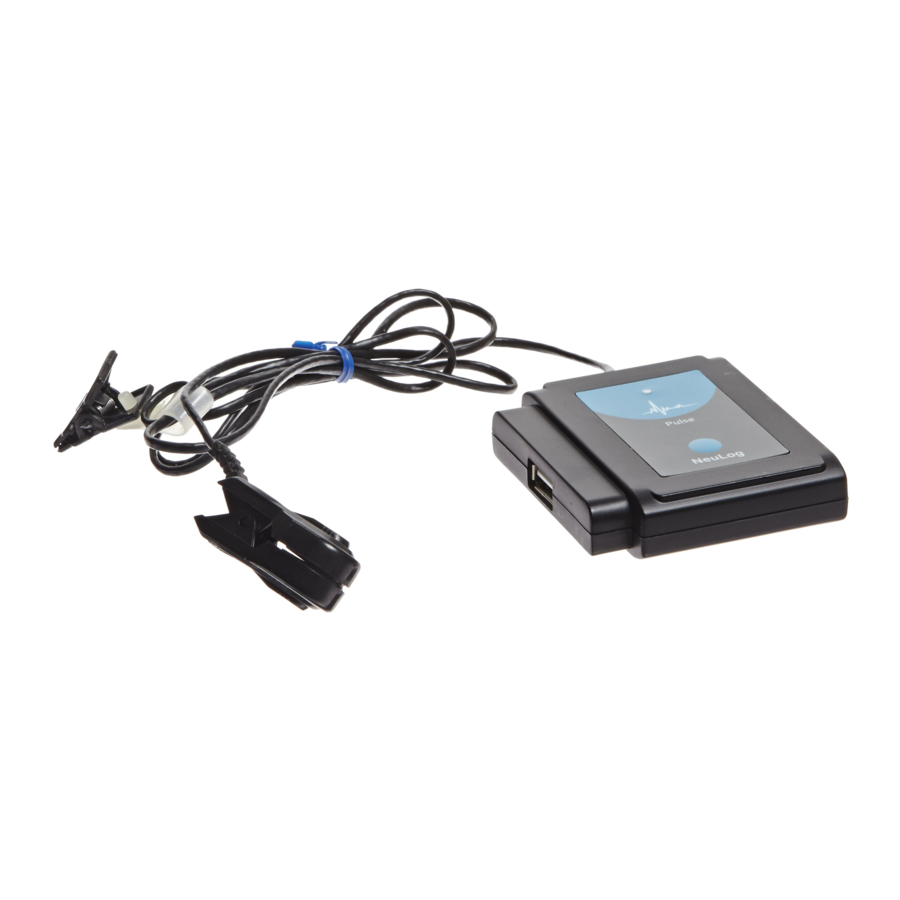
Advertisement
Quick Links
NeuLog heart rate and pulse logger sensor
NUL-208
The NeuLog pulse sensor can be used for any science experiment which
requires a human heart rate or pulse such as in the fields of Biology, Health
Sciences, Physiology, Exercise Science, Psychophysiology, etc.
The sensor comes pre-calibrated so you can start experimentation right out
of the box using this guide.
Heart rate can be measured in two ways with this sensor: in beats per
minute or in analog arbitrary values to demonstrate the wave signal of a
heartbeat showing the blood volume in the finger or earlobe.
Hundreds of possible experiments that can be performed with the NUL-208
sensor are: physiological experimentation, relationship between heart rate
and oxygen flow, blood volume, psychological experiments which utilize
heart rates, lie detection, exercise experiments, VO
metabolism.
The heart rate and pulse sensor has two possible units of measurement:
Beats Per Minute (BPM): The amount of heart beats per minute
Arbitrary analog units (Arb): An arbitrary unit meant to show wave
functions.
Probe usage:
The sensor consists of an infrared LED transmitter and a matched infrared
phototransistor receiver (light detector).
For best results:
Quick start procedure:
PC or Mac Computer
Materials needed:
max experiments and
2
NUL-208 Heart Rate and Pulse Sensor
USB-200 USB Module
USB to mini USB cable (included with the USB-200 module)
Your heart rate and pulse sensor needs to be connected to a USB-200
module. The USB-200 module then connects to a computer via a USB to
mini-USB cable. Please note that you cannot plug the heart rate and pulse
sensor directly into the computer.
Resident PC software and browser based application can be downloaded for
free at
www.neulog.com/Download/SoftwareandApplication.aspx
software user guide.
NEULOG PULSE SENSOR GUIDE
Wash hands before use.
Clip sensor to the little finger (pinky) or earlobe.
For better results, place the light detector (has white transparent cover)
side of the clip on the pad of your finger, not the nail.
Remain as still as possible until testing is complete.
Nail polish can skew the results.
Let signal stabilize before reading.
as well as a full
Advertisement

Subscribe to Our Youtube Channel
Summary of Contents for NeuLog NUL-208
- Page 1 The sensor consists of an infrared LED transmitter and a matched infrared phototransistor receiver (light detector). The NeuLog pulse sensor can be used for any science experiment which For best results: requires a human heart rate or pulse such as in the fields of Biology, Health ...
- Page 2 The WIFI-201 module will create a closed NeuLog WiFi network Procedure: which will stream the NeuLog data to the device of your choosing. Once your device is wirelessly connected to the NeuLog network you can run Install the NeuLog software.
- Page 3 Once the sensor appears it will be monitoring data in real time. To run an experiment and collect data click the run button (little green Select which experimental data to upload (5 experimental runs can be person). stored at one time on the NUL-208 heart rate and pulse sensor).
- Page 4 http://neulog.com/Heartrateamppulseloggersensor.php Included with sensor: Heart Rate and Coughing - http://neulog.com/portals/3/Users/Experiment_B- NeuLog NUL-208 Heart Rate and Pulse Sensor Guide (this document). 18_Heart_Rate_and_Coughing_Ver_3.2.5.pdf Fingertip/earlobe clip with IR receiver transmitter. Heart Rate and Physical Activity - http://neulog.com/portals/3/Users/Experiment_B- 19_Heart_Rate_and_Physical_activity_Ver_3.2.8.pdf...
- Page 5 Technical background: Maintenance and storage: The philosophy behind NeuLog’s plug and play technology is based on Never submerge the NeuLog plastic body in any liquid. each sensor’s ability to store its own data due to an internal flash memory ...


Need help?
Do you have a question about the NUL-208 and is the answer not in the manual?
Questions and answers